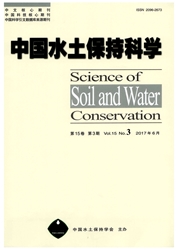

 中文摘要:
中文摘要:
颗粒侵蚀是裸露的岩石在阳光暴晒和热胀冷缩作用下破碎,呈颗粒状剥离沿坡面滚落,在坡脚形成碎屑堆积扇的现象。汶川地震发生后,江河沿岸无数的山体崩塌与滑坡造成了大片完全裸露的山体,颗粒侵蚀面积急剧扩大。颗粒侵蚀对植被造成毁灭性破坏、造成飞石伤人和大量坡面泥石流。通过调查和野外实验研究了颗粒侵蚀的规律及其治理方法,发现阳光暴晒和温差变化是岩石表面呈颗粒状脱离的主因,风吹和震动是颗粒从陡坡滚落的触动力。采用鼓风机在野外试验,发现颗粒吹落量和吹落颗粒粒径与风速存在一定关系,并且颗粒侵蚀可以快速治理,在颗粒侵蚀面上喷洒带有苔藓孢子粉的稀泥浆,2个月后长出苔藓层,隔断了阳光暴晒和温差变化,控制了颗粒侵蚀。如果在震区采用直升飞机喷洒苔藓孢子粉泥浆,可以大面积快速修复植被。
 英文摘要:
英文摘要:
Grain erosion is defined as the phenomenon of detachment of grains from bared rocks under the action of insolation,temperature changes,and freezing and thawing,movement down a steep slope triggered by wind and shaking,and cumulates at the toe of the mountain forming a deposit fan.The Wenchuan Earthquake,occurred in Sichuan on May 12,2008,caused numerous rockfalls,avalanches and landslides,which damaged vegetation and left scars on high slopes.Consequently grain erosion occurred throughout the earthquake area.Grain erosion caused flying stones injuring humans,and resulted in numerous slope debris flows.The laws of grain erosion and control measures are studied by field investigations and field experiments.It is found that the most serious grain erosion occurred in spring and early summer because of intensive insolation of sunshine and temperature change. Wind is the triggering agent for grain falling from the slope.Experimental results show that the amount of grains falling from the slope per time is proportional to the fourth power of wind speed and the size of grains increases linearly with the wind speed.The experiments also demonstrate that grain erosion may be controlled with some moss species.Moss spores were mixed with clay suspension and splashed on the bared rock.A layer of green moss appeared on the rock and stopped the grain erosion,because the moss layer cut off the sunshine and mitigates temperature difference.Many huge bared mountains suffering grain erosion in the earthquake area can be quickly greened by using helicopter to spray moss spores and clay suspension.
 同期刊论文项目
同期刊论文项目
 同项目期刊论文
同项目期刊论文
 期刊信息
期刊信息
